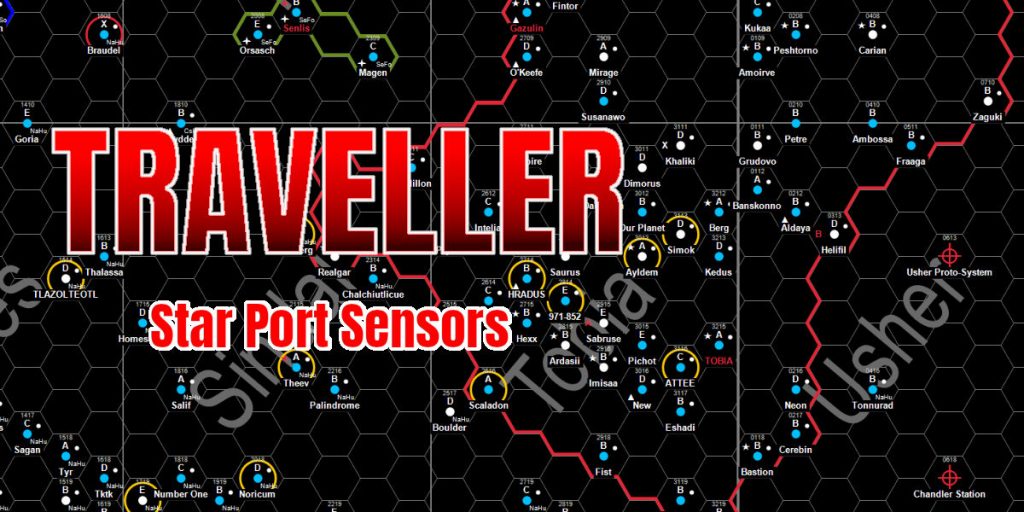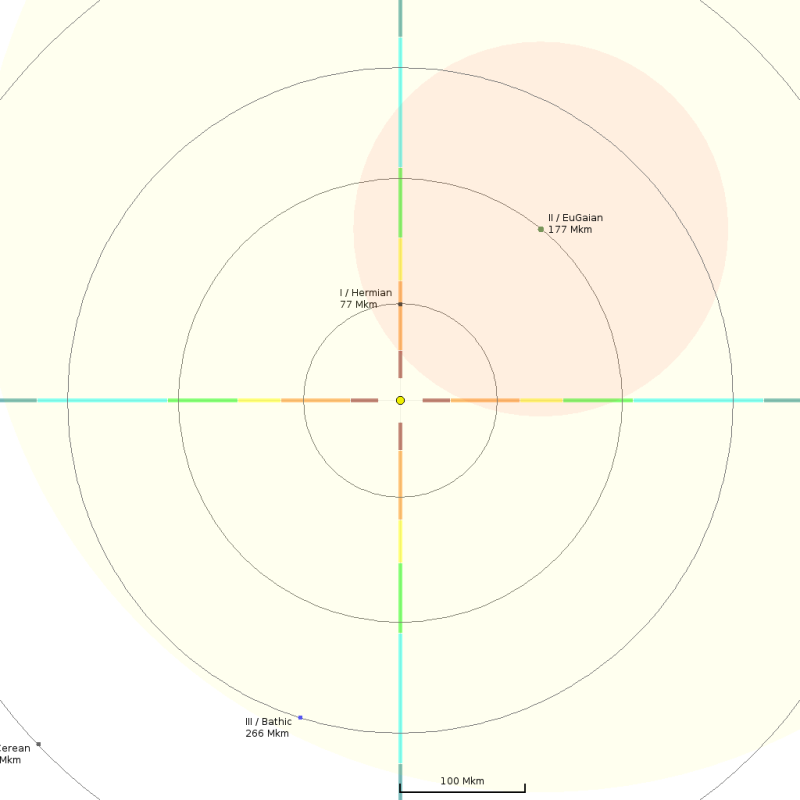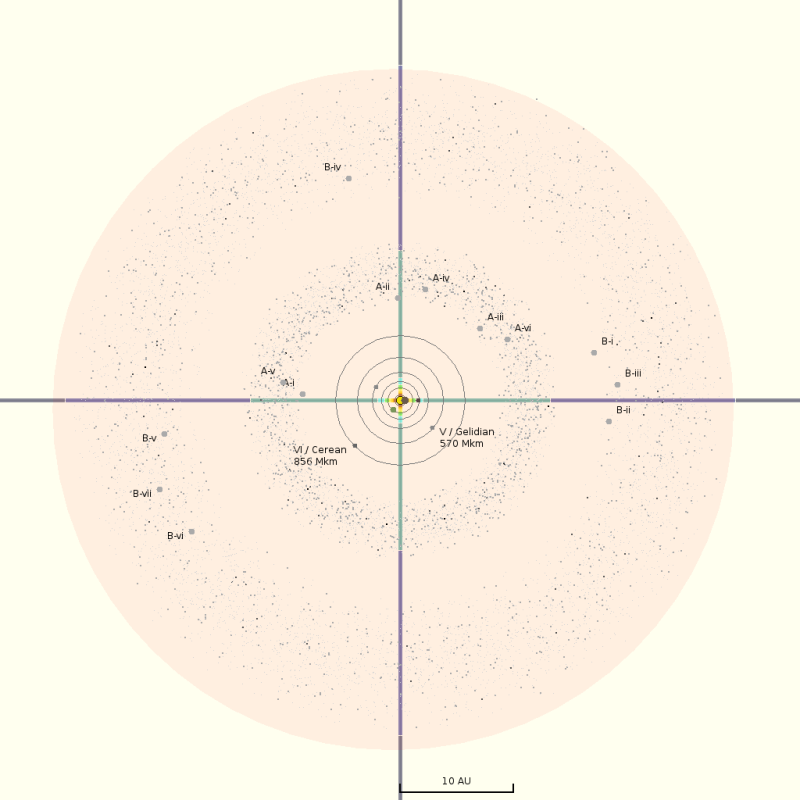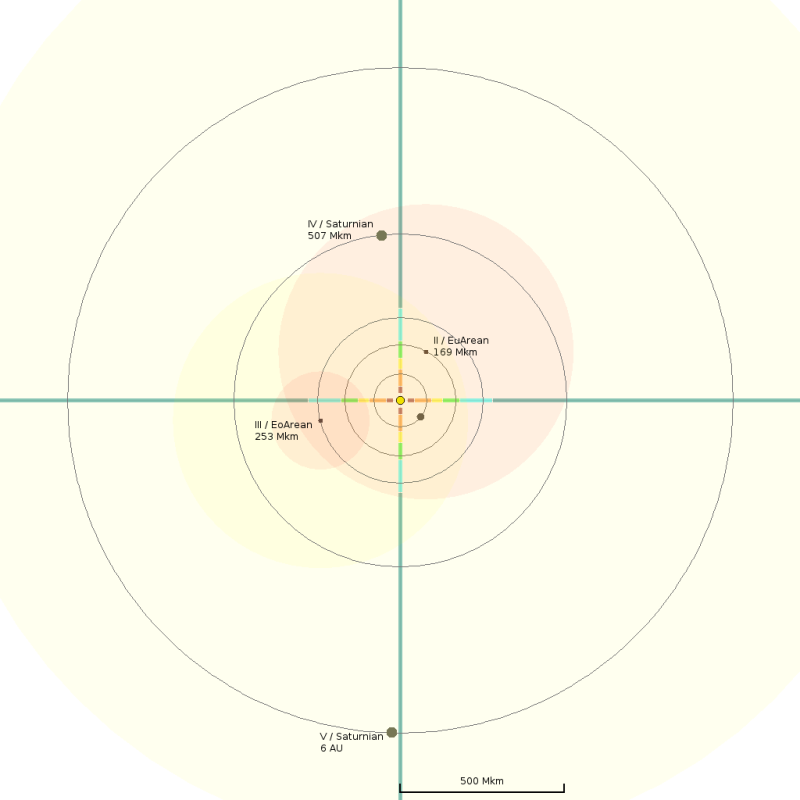System Sensors

Traveller may have magic FTL drives, but it doesn’t have magic sensors or communications (beyond sticking a message on a magic FTL ship), so it seems reasonable to limit what a settlement in a star system is able to detect. For game purposes, the important thing is how far away from a star port does a ship have to be before it is detected?
This is helpful to know both for players wanting to avoid being detected themselves, and also for players who want to know the ‘safe’ zone for a system. Pirates are less likely to be active if the local star port is able to track them, so staying within monitored space will be safer. I wrote up some rough rules for this a long time ago (for Mongoose Traveller 2nd edition), but recently decided that it might be useful to show this information on my star system maps. It’s possible that I might tweak the numbers a bit over time after I’ve seen how they play out. I want to allow room for criminal activity in backwater systems, whilst having decent ranges at primary worlds.
There are two main aspects to this – detecting jump activity, and tracking the position and identity of ships.
Detecting jump activity is, as it suggests, knowing when a ship comes out of jump, or enters a jump. A burst of neutrino radiation (IMU) will be detectable when this happens, and sensors capable of picking this up need to be at least TL 9. However, any major star port will have this sort of technology available, even if it has to be shipped in from out of system, so even low tech worlds will have some capability here, though it will be reduced.
| Starport | Transponders | Jump Activity | Vector |
| A++ | 100 AU | 60 AU | 2+ |
| A+ | 60 AU | 30 AU | 3+ |
| A | 30 AU | 10 AU | 4+ |
| B | 10 AU | 3 AU | 5+ |
| C | 3 AU | 1 AU | 6+ |
| D | 1 AU | – | |
| E | – | – | |
| X | – | – |
For tracking ship positions, it is assumed that every ship has a transponder which broadcasts their position and identity on a continuous basis. This can be detected by ships with basic sensor systems, but is also tracked by the local star port. The range at which a star port tracks this information is classed as ‘monitored space’, and ships within this are the responsibility of the local space traffic control. It probably also roughly equates to the region over which security patrols are likely to roam.
The table on the left shows the typical ranges for detecting jump activity and ship transponders, based on the size of the star port. The larger the star port, the greater the range at which detection is performed. Modifiers (see below) can increase a port’s capabilities beyond that of a typical A class port.
E class star ports generally don’t have much in the way of sensor capability, though they may have limited capability on high tech or high population worlds (though such worlds are unlikely to just have an E class star port). A world with no star port (X) could also theoretically still have sensor capability, but it won’t be managed by the star port authority but by local governments.
Modifiers
- World population is one billion or more: increase range by one band (a B class becomes an A class)
- World TL is 13 or higher: increase range by one band
- World TL is less than 9: decrease range by one band
- If there is a navy base present, then double the final ranges for the given band
The above modifiers stack, so a B class starport with TL 14 and a population of 3 billion would be treated as A+.
A naval base double the actual numbers, so the above B class starport with a naval base would be monitoring transponders out to 120 AU, and jump activity out to 60 AU. A D class starport with a naval base will not be monitoring jump activity at all (since double zero is zero).
So what does this look like? For example, a world with a C class starport, and no other modifiers, would have a jump detection range of 1 AU, and be monitoring space out to 3 AU, giving a radar coverage of most of the inner system.

If the planet had a low tech level, then it would still be monitoring the same space, but wouldn’t have any jump detection capability. Note that if a ship comes out of jump, its transponder will start signalling which will be picked up, so it’s reasonably easy to assume that a ship has entered/left jump based on transponder detection.

Jump Activity
Detection of jump activity will detect the presence of a jump, as well as some details of direction and distance. If it’s important for the starport to have an accurate idea of the destination or departure point for a ship, roll a d6. If it makes the Vector target given on the above table, then the hex of destination or departure is known. On failure, roll a second time. If the second roll is a success, information is inaccurate – randomly determine one of the six hexes neighbouring the destination/departure point. If the second roll fails, no information is gained.
If the ship has a stealth jump drive, then reduce the detection ability by two categories. So ‘A+’ sensors would detect the ship out to 3 AU, and only get vector information on a 6+.
Larger ships should probably be easier to detect since they will have a larger jump signature. A ship that is 5,000t or larger can be detected out to twice the normal range, and a ship of 50,000t or larger out to three times.
Detection is still limited by speed of light, so if a ship jumps into the system at a range of 1 AU and would be detected, it would be over 8 minutes before the starport is aware of this. A ‘rough’ figure to use that is easy and probably good enough is that it will take 10 minutes per AU to detect a ship.
Since I assume detection is by neutrinos, and neutrinos pass through most matter (TL 9+ sensors have ways of coping with this), you can’t hide your activity by jumping behind a star or planet.
Note that these rules are for star ports, not ships. Star ports will have much bigger, distributed sensor arrays than a ship can normally carry. According to the rules in the Deepnight Revelation campaign, the Deepnight can track jump activity out to many parsecs. I’m planning on either ignoring this, or assuming it only works for detecting a large number of ships over a period – it can’t detect a single jump signature, but may detect the presence of a busy star port.
Transponders
Transponders are tied into a ship’s drives, and are illegal for civilians to switch off. They are also hard to switch off without disabling the drives completely so even a lot of pirate ships will have transponders. Military ships often have an option to switch off their transponders, but normally keep them on in friendly systems.
| Sensors | Range |
| Basic | 50 Mkm |
| Civilian | 1 AU |
| Military | 3 AU |
| Improved | 6 AU |
| Advanced | 10 AU |
Since transponders are broadcast, they can be picked up by any ship with even basic sensors at much larger distances than normal detection ranges. This can also be considered the distance at which it’s easy for two ships to have a conversation. A ship with weaker sensors can by ‘heard by’ a ship with better sensors, but may not be able to hear the other ship.
Transponders broadcast the name of the ship, it’s current position and vector, as well as basic communication information such as public keys to enable secure communication. The broadcast isn’t always continuous, but a pulse sent out every few minutes. More continuous position info may be sent out as ships approach each other or a star port, with a weaker signal strength.
Most star ports (those of class C or larger) make information about ships in their monitored space available to anyone who wants it, though it may sometimes be charged for or require an official request.
Detecting Hidden Ships
The ranges given are typical ranges assuming that the star port has no particular interest in the ship in question. It’s always possible to focus sensors in a particular direction to try and pick up ships at greater ranges, and this is also true for jump activity. A reasonable rule of thumb is that it’s possible to double these ranges with a good Electronics (Sensors) check and some time, but they won’t be automatically detected.
A ship without any broadcasting transponder will still be visible using basic radar, IR and other detection methods. Generally, most ships will be automatically detected by a star port within one tenth of the above ranges. Detection at greater distances will be possible, but again various Electronics (Sensors) checks will be needed, and star port traffic control will need a reason to be looking.
Naval bases will perform regular sensor sweeps, deliberately checking for hidden ships, and can be assumed to eventually pick up anything up to double their normal transponder distance, but it may take many days. Whether a ship is actively manoeuvring or what, and how big it is, will modify this, but I’m not going into details on that yet.
Finally, the above all assume that the sensors are based at an individual world, so if there are multiple star ports (or space ports) within a system then there may be multiple overlapping sensor ranges. One thing I haven’t worked out is how this works for asteroid belts. Presumably the space port will be at a specific location, so the sensors will be based there, but my system maps don’t currently cope with this.

“According to the rules in the Deepnight Revelation campaign, the Deepnight can track jump activity out to many parsecs. I’m planning on either ignoring this, or assuming it only works for detecting a large number of ships over a period – it can’t detect a single jump signature, but may detect the presence of a busy star port.”
I’d probably also extend that to having the information inherently out of date by years. Now, that system with a busy start port 6 years ago probably still has one but it is certainly possible that an adventure plot started since then.
Yeah, it’s all limited by speed of light, so they could pass through a light cone covering a couple of decades of history before getting to the destination. 10 parsecs away… busy. 6 parsecs away… busy. 3 parsecs away…. complete silence.
I’ve recently discovered that The Traveller Companion (Mongoose 2nd) has some quite detailed rules on Transponders, and there is an option to disable them. This is logged in the ship’s computer though, and may be checked (and questioned) at the next civilised starport.